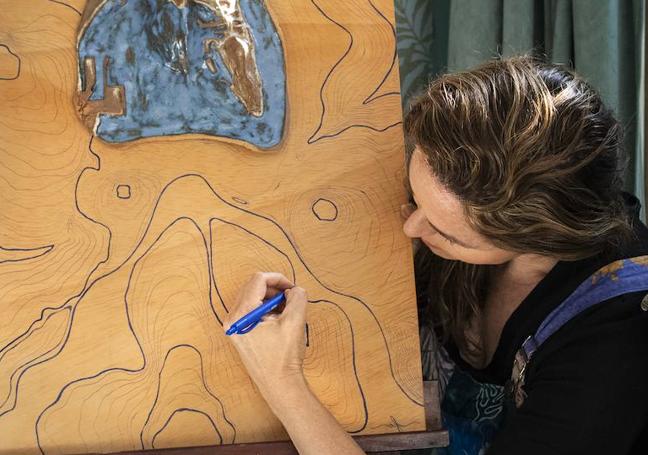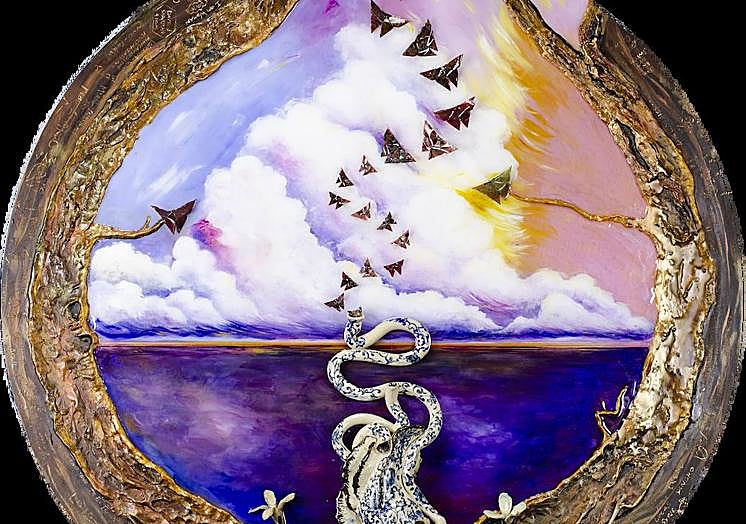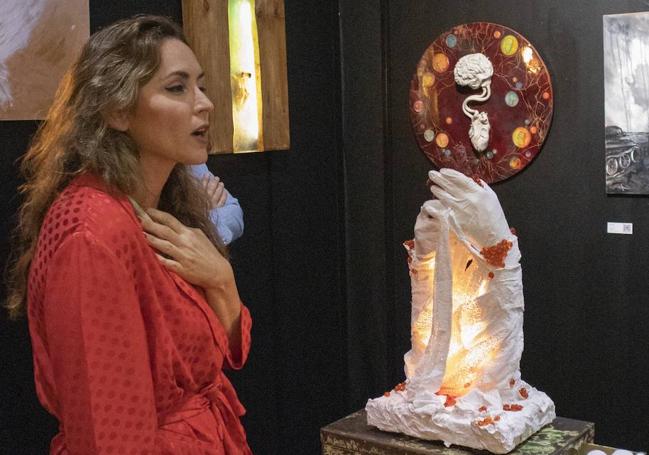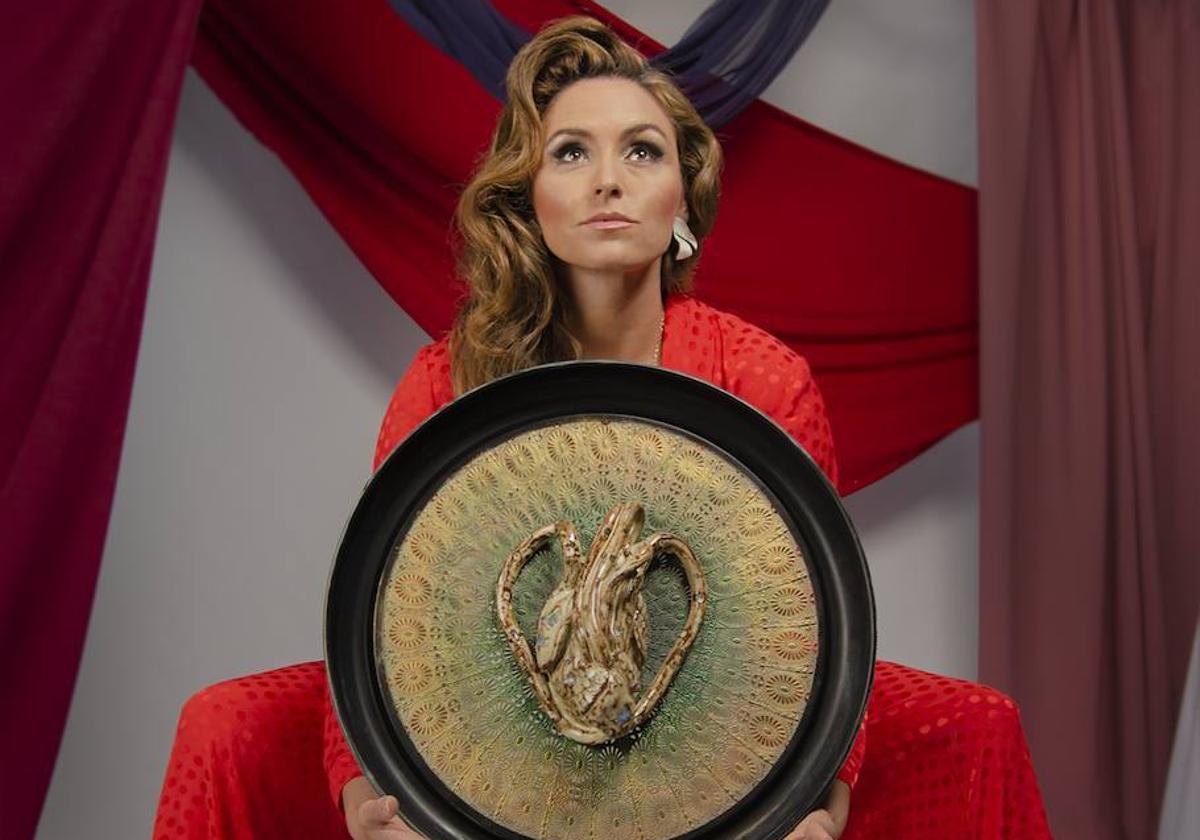99 hearts, but not for Valentine's Day
Syrie Jo Blanco Walsh was born in Malaga - her mother's way of procuring an artistic future for her daughter; she is now exhibiting her work in La Línea - as many exhibits as there were days of lockdown in Spain
She was born in Malaga at her mother's wish, who wanted to deliver her daughter in the birthplace of Pablo Picasso. From there, she went to San Roque, in Cadiz, where the family settled, comprised of this Irish wife, her Spanish husband, and their new daughter. That was her way of "pushing destiny," Syrie Jo Blanco Walsh joked, during her exhibition in La Línea de la Concepción, which displays her creation of 99 hearts. Though nothing to do with Valentine's Day, each one represents a day of lockdown in Spain during the Covid-19 pandemic. Her supposedly preordained future also has another aspect to it: she is named after the daughter of American artist Gino Hollander, a family friend who lived for a while on the Costa del Sol and is also a creator.
In fact, this Malaga-born artist graduated in Fine Art from the European University of Madrid and did a Master's in Contemporary Art. During the pandemic, she brought forth what she describes as her most ambitious project so far, which is on show until 2 March. On the afternoon of Friday 1 and Saturday 2 March, Blanco Walsh will round off the exhibition with a closing event, accompanied by performances. The occasion will take place at the José Cruz Herrera Museum in La Línea de la Concepción, where the artist also resides and runs a restaurant.

During the days of lockdown in 2020, Blanco Walsh began working with whatever materials she had at home, such as ink or gold leaf. She explains how the organs of the human body have always caught her attention as elements through which to express herself artistically. On that occasion, she chose the heart as the symbol for her creation. This heart, however, is far from the commercial, perfectly-shaped types that fill shop windows on Valentine's Day. Instead, Syrie Jo Blanco Walsh depicts the heart in its true form: as the organ that pumps life to the rest of the body through its arteries and veins.
"The heart thinks," she says, alluding to a statement by a university professor during one of his guided tours. He explained that there has been research to suggest that the heart, like the brain, contains neurons, few as they may be. Perhaps the heart can reason in ways that the mind cannot.
Throughout lockdown, the artist created fifteen hearts, although her goal was to reach 99, representing the precise number of days that people in Spain spent in lockdown, in what is now a very distant memory. It took her three and a half years to achieve her goal and complete her creative process.
Testimonies from the pandemic
As well as reuniting techniques such as ceramics, resin, and ink, among others, the artist's creation illustrates several themes around the pandemic, from domestic situations, to new or frustrated dreams, as well as trauma, struggle, war, death, hope, and climate change. It is accompanied by 20 interviews of people from a range of professions, whose testimonies combined capture the shock that the world experienced in 2020. They depict doctors, nurses, hoteliers, pharmacists, and psychologists, who recount times of mask hoarding; Blanco Walsh's own Irish grandmother who had to live through the pandemic alone in Dublin; an art teacher who struggled with online lessons so much that he decided to take early retirement. Even the mayor of La Línea himself recalls what it was like to manage an entire municipality from home.
To remember: to pass back through the heart
The spirit of Blanco Walsh's creation is remembrance - that could be the 100th heart. As the Uruguayan writer Eduardo Galeano said, "to remember" comes from the Latin "re-cordis," meaning "to go through the heart again".
In her exhibition, the artist's work is spread over four rooms, through which she guides visitors with her smooth, velvety voice. The curtains that separate each room provide just the right touch of mystery, adding a little surprise factor.
The first of these rooms portrays what any home's living room would have looked like during the pandemic: converted into what was simultaneously a living room, office, classroom, and playroom for the children. The living room was also the "heart" of the house's toilet paper, the most recent and paradigmatic example of the snowball effect of compulsive accumulation by many households, which emptied supermarket shelves. It was, moreover, the heart of the four seasons, indicating how time went by, and how lockdown, initially meant to last two weeks, ended up consuming part of winter, all of spring, and the beginning of summer.
The second room is carpeted with a texture that simulates grass. It represents the phase of lockdown when it was possible to go outside, onto the street, or, if you were lucky, into your garden, terrace, or balcony. If these chances to go out provided literal and figurative oxygen, nature was also given a period of respite due to the pandemic bringing economic activity to a near-standstill. This is represented in the artist's work through the dead, white coral, which recovers its healthy pink colour.
Next, we observe Blanco Walsh herself on display, with a heart that represents Ireland, in homage to her grandmother, and which embodies the solidarity felt at the time by people all over the world for the elderly community. The artist has even created her own heart, in which we can discern several elements that define her: the olive tree; the clover; butterflies, which are omnipresent - they spend half of their lives crawling as a caterpillar before they break out of their cocoon and fly. In her creation, we also observe tattoos (which she herself does not have) with names and events that have marked her life, and to which she will add more in the future.
For Blanco Walsh, one of these events is the pandemic itself, a time when many people re-evaluated their lives and planned their next steps. It was then, she says, that she came to her conclusion: she was going to distance herself from her distractions to focus on what she was truly passionnate about, which is communicating, teaching, and remembering through art.
Monet and Pollock

The third room is that of escapism: of journeys made and those dreamed of but which could not be made; of the artists who inspire her, such as Monet and Pollock; and of stargazing - Blanco Walsh also took part in the frenzy to buy a telescope and gaze at the clearest skies that the pandemic brought with it.
During those days, we stargazed, but we also became bakers, binge-watched TV series, pondered our lives, and thought about what we wanted to be different. All these themes are very present in the artist's exhibition.
Out of all four rooms, it is the last one whose content is the heaviest. It is even slightly gloomy, although Blanco Walsh always tries convey hope, which is why many of her works radiate a light amid the darkness. This room is presided over by a sculpture, representative of all those who medicine could not heal because they were so ill with Covid; whose operations were cancelled; who died, but who, in different circumstances, could have received an earlier diagnosis that could have saved them. All these people deserve this work of remembrance, which also recognises the tireless work of doctors and nurses, full of goodwill but sometimes with their hands tied from the widespread collapse of health care.

A prominent place in the collection is occupied by a heart dedicated to María, a 35-year-old woman who died of breast cancer, and left behind two young children who became orphans just a few days after the exhibition's opening in La Línea. There is also a heart that pays homage to the war in Ukraine, whose onset coincided with the last throes of Covid, and which now coincides with the outbreak of war in the Middle East. There is, moreover, a tribute to the volanic eruption in La Palma, which lasted more days than it took the artist to complete this impressive work.
The pandemic is by no means over, and continues to impact the economy in ways that Blanco Walsh herself can attest to, as the self-employed owner of a restaurant. This is, in fact, one of the exhibition's last hearts, which reveals the financial burdens of a self-employed worker.
The artist has already sold over half of her collection. The only bad news for spectators who appreciate the spirit of remembrance, is that this capsule of unprecedented historical moments cannot be reunitied in another exhibition. Syrie Jo Blanco Walsh, however, is confident that she will be able to do so. Having located the majority of her buyers, she trusts that they will give her the creations at a given moment when we are to once again remember the different moments that disturbed the daily life of all humanity. Art has to circulate, it has to move, it has to be seen.

